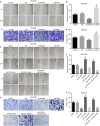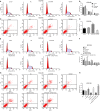Down-regulation of long non-coding RNA HOTAIR inhibits invasion and migration of oesophageal cancer cells via up-regulation of microRNA-204
- PMID: 31389660
- PMCID: PMC6787447
- DOI: 10.1111/jcmm.14502
Down-regulation of long non-coding RNA HOTAIR inhibits invasion and migration of oesophageal cancer cells via up-regulation of microRNA-204
Abstract
Oesophageal cancer is a progressive tumour with high mortality. However, therapies aimed at treating oesophageal cancer remain relatively limited. Accumulating studies have highlighted long non-coding RNA (lncRNA) HOX transcript antisense RNA (HOTAIR), microRNA-204 (miR-204) and homeobox C8 (HOXC8) in the progression of oesophageal cancer. Herein, we tried to demonstrate the function of HOTAIR, miR-204 and HOXC8 in oesophageal cancer and their relationship. Differentially expressed genes involved in oesophageal cancer were identified. The endogenous expression of HOTAIR and miR-204 in oesophageal cancer cell lines was altered to elucidate their effects and to identify the interaction among HOTAIR, miR-204 and HOXC8. We also explored the underlying regulatory mechanisms of HOTAIR and miR-204 with siRNA against HOTAIR, miR-204 mimic or miR-204 inhibitor. Cell proliferation, migration, invasion and apoptosis were subsequently detected. Xenograft in nude mice was induced to evaluate tumourigenicity. miR-204 was down-regulated, while HOTAIR and HOXC8 were up-regulated in the oesophageal cancer tissues. HOTAIR could competitively bind to miR-204 and miR-204 could further target HOXC8. The oesophageal cancer cells treated with si-HOTAIR or miR-204 mimic exhibited decreased expression levels of HOXC8, Vimentin and MMP-9, but increased E-cadherin level. Silenced HOTAIR or elevated miR-204 inhibited proliferation, migration and invasion, along with stimulated apoptosis of oesophageal cancer cells. In summary, our results show that lncRNA HOTAIR could specifically bind to miR-204 as a competing endogenous RNA and regulate miR-204 and HOXC8. Hence, down-regulation of HOTAIR could inhibit progression of oesophageal cancer, indicating a novel target for oesophageal cancer treatment.
Keywords: HOX transcript antisense RNA; MicroRNA-204; homeobox C8; invasion; long non-coding RNA; migration; oesophageal cancer; proliferation.
© 2019 The Authors. Journal of Cellular and Molecular Medicine published by John Wiley & Sons Ltd and Foundation for Cellular and Molecular Medicine.
Figures









Similar articles
-
Long non-coding RNA HOTAIR functions as miRNA sponge to promote the epithelial to mesenchymal transition in esophageal cancer.Biomed Pharmacother. 2017 Jun;90:888-896. doi: 10.1016/j.biopha.2017.03.103. Epub 2017 Apr 22. Biomed Pharmacother. 2017. PMID: 28441714
-
Long non-coding RNA HOTAIR, a driver of malignancy, predicts negative prognosis and exhibits oncogenic activity in oesophageal squamous cell carcinoma.Br J Cancer. 2013 Oct 15;109(8):2266-78. doi: 10.1038/bjc.2013.548. Epub 2013 Sep 10. Br J Cancer. 2013. PMID: 24022190 Free PMC article.
-
Long non-coding RNA HOTAIR/microRNA-206 sponge regulates STC2 and further influences cell biological functions in head and neck squamous cell carcinoma.Cell Prolif. 2019 Sep;52(5):e12651. doi: 10.1111/cpr.12651. Epub 2019 Jul 11. Cell Prolif. 2019. PMID: 31297902 Free PMC article.
-
In silico interaction of HOX cluster-embedded microRNAs and long non-coding RNAs in oral cancer.J Oral Pathol Med. 2022 Jan;51(1):18-29. doi: 10.1111/jop.13225. Epub 2021 Aug 16. J Oral Pathol Med. 2022. PMID: 34358375 Review.
-
Emerging roles of HOTAIR in human cancer.J Cell Biochem. 2020 Jun;121(5-6):3235-3247. doi: 10.1002/jcb.29591. Epub 2020 Jan 14. J Cell Biochem. 2020. PMID: 31943306 Review.
Cited by
-
HOTAIR as a diagnostic and prognostic biomarker of gastrointestinal cancers: an updated meta-analysis and bioinformatics analysis based on TCGA data.Biosci Rep. 2023 Mar 31;43(3):BSR20222174. doi: 10.1042/BSR20222174. Biosci Rep. 2023. PMID: 36924407 Free PMC article.
-
The Emerging Role of Long Non-Coding RNAs in Esophageal Cancer: Functions in Tumorigenesis and Clinical Implications.Front Pharmacol. 2022 May 13;13:885075. doi: 10.3389/fphar.2022.885075. eCollection 2022. Front Pharmacol. 2022. PMID: 35645836 Free PMC article. Review.
-
The roles and mechanisms of the lncRNA-miRNA axis in the progression of esophageal cancer: a narrative review.J Thorac Dis. 2022 Nov;14(11):4545-4559. doi: 10.21037/jtd-22-1449. J Thorac Dis. 2022. PMID: 36524088 Free PMC article. Review.
-
Role of non-coding RNAs in human-papillomavirus-associated cutaneous neoplasms.Arch Virol. 2025 Jun 29;170(8):170. doi: 10.1007/s00705-025-06335-0. Arch Virol. 2025. PMID: 40581896 Review.
-
Medulloblastoma malignant biological behaviors are associated with HOTAIR/miR-483-3p/CDK4 axis.Ann Transl Med. 2020 Jul;8(14):886. doi: 10.21037/atm-20-5006. Ann Transl Med. 2020. Retraction in: Ann Transl Med. 2024 Dec 24;12(6):129. doi: 10.21037/atm-2024-8. PMID: 32793730 Free PMC article. Retracted.
References
-
- Song Y, Li L, Ou Y, et al. Identification of genomic alterations in oesophageal squamous cell cancer. Nature. 2014;509:91‐95. - PubMed
-
- Holmes RS, Vaughan TL. Epidemiology and pathogenesis of esophageal cancer. Semin Radiat Oncol. 2007;17:2‐9. - PubMed
-
- Bhatt L, Tirmazy S, Sothi S. Intraluminal high‐dose‐rate brachytherapy for palliation of dysphagia in cancer of the esophagus: initial experience at a single UK center. Dis Esophagus. 2013;26:57‐60. - PubMed
-
- Liu Z, Yang T, Xu Z, Cao X. Upregulation of the long non‐coding RNA BANCR correlates with tumor progression and poor prognosis in esophageal squamous cell carcinoma. Biomed Pharmacother. 2016;82:406‐412. - PubMed
MeSH terms
Substances
LinkOut - more resources
Full Text Sources
Medical
Research Materials
Miscellaneous

